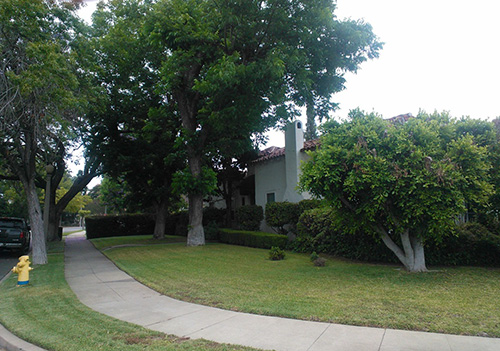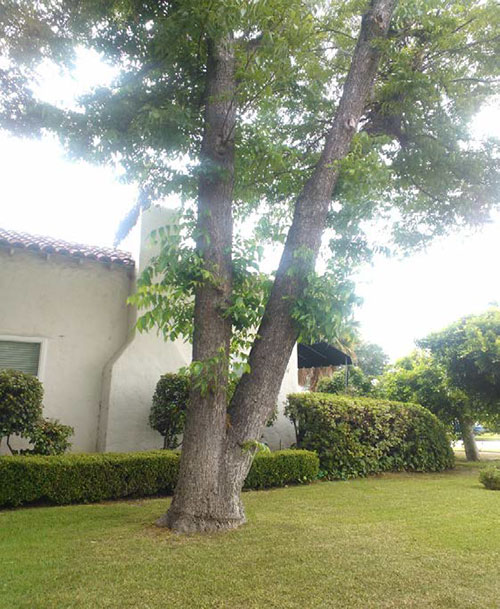Case Report: 12CA010
Tree trimmer dies when he falls from a tree
Download a PDF to print this report:
Tree trimmer dies when he falls from a tree (12CA010, PDF)
Summary
A tree trimmer died from injuries received when he fell approximately 30 feet out of the tree he was trimming. He braced his leg on a branch for leverage as he attempted to start a chain saw that was attached to his tool belt. When the branch broke, the victim lost his balance and fell to the ground below. The victim was not secured to the tree even though he was wearing a tree climbing harness with attached lines, positioning lanyard, and climbing gaffs at the time of the incident. The victim was not trained or certified by any arborist or tree association. The CA/FACE investigator determined that in order to prevent future incidents, tree trimming companies and self-employed tree trimmers should ensure that:
- Proper work procedures and equipment are used.
- Tree trimming is performed or supervised by tree workers who have been trained and certified by organizations such as the Tree Care Industry Association (TCIA) or the International Society of Arboriculture (ISA).
In addition, homeowners who need trees trimmed or removed should:
- Hire only tree trimmers who are trained and certified by organizations such as the TCIA or ISA.
Introduction
On Friday, September 14, 2012, at approximately 9:30 a.m., a 53-year-old Hispanic male tree trimmer died when he fell approximately 30 feet out of a tree to the ground below. The CA/FACE investigator received notification of this incident on September 25, 2012, from the Los Angeles District Office of the Division of Occupational Safety and Health (Cal/OSHA). On December 21, 2012, the CA/FACE investigator went to the incident site and interviewed the homeowner and took pictures of the tree involved in the incident. On January 18, 2013, the owner of the tree maintenance and service company was interviewed. Family members of the victim were later interviewed by phone. Transcripts from the police interview with the co-worker were obtained.
Employer
The victim and another co-worker were hired by a tree maintenance and service company that had been in business for 10 years. The company consisted of the owner who stated she was the only employee. However, the company was later cited by Cal/OSHA as the employer of the victim. She stated that her company solicits and negotiates landscaping maintenance and service jobs from homeowners and then hires tree trimmers and gardeners to perform the work. In this incident, a homeowner paid the company owner to locate tree trimmers to trim the trees in his yard. The homeowner had used this company many times in the past to maintain his trees.
Written Safety Programs and Training
The company did not have a written injury or illness prevention program (IIPP) or any formal employee training in tree trimming. The victim learned the trade from other gardeners and tree trimmers but did not receive any formal training with this company.
Worker Information
The victim was a 53-year-old Hispanic male tree trimmer and gardener who was hired by the company along with another co-worker. The owner stated that she had known the victim for three years and hired him many times in the past. According to a family member of the victim, he had worked as a gardener and trimmed trees for over 20 years. The victim had lived in the United States for eight years and had completed three years of elementary education.
Incident Scene
The incident scene was the front yard of a private residence (Exhibits 1 & 2).
Weather
The weather on the day and at time of the incident was sunny and clear with a mild southwesterly breeze and a temperature of 85 degrees.
Investigation
On the day of the incident, the victim arrived at approximately 8:00 a.m. at the private residence to trim two walnut trees in the front yard. At 9:00 a.m. his co-worker arrived, and she found the victim already about 30 feet up in the first tree, trimming branches and letting them fall to the ground below. She stated that the victim was wearing a tree climbing harness with a lanyard and was wearing climbing gaffes. However, the victim did not secure himself to the tree with the lanyard. He pulled up a chainsaw that was attached to his tool belt. When the victim attempted to start the chain saw, he braced his leg against a branch for leverage as he pulled on the starter rope with one hand and held the chainsaw with the other. The tree limb on which his foot was braced broke. The victim lost his balance and fell to the ground below onto a pile of cut branches. The victim’s co-worker dialed 911 on her cell phone. The fire department and paramedics transported the victim to a local hospital where he died later that afternoon as a result of his injuries.
Cause of Death
The cause of death according to the death certificate was traumatic injuries.
Recommendations
Tree trimming companies and self-employed tree trimmers who trim trees should ensure that:
Recommendation #1: Proper work procedures and equipment are used.
Discussion: In this incident, the victim climbed the tree wearing a climbing harness, lanyard, and gaffes, but did not secure himself to the tree. When the victim attempted to start the chain saw, he used a tree branch to brace his leg as he pulled on the starter rope. This force caused the branch to break and the victim lost his balance and fell to the ground. It is not known why the victim did not secure himself to the tree. Employers should ensure that employees are tied off at all times when located within a tree and have, at a minimum, two means of being tied off. Employers should prohibit free climbing (climbing without the use of fall protection) and ensure arborists are tied off at all times while climbing. This requires employees to have two means to tie-off so they can move past obstacles and always maintain protection from a fall. Having two means of being secured provides the arborist the ability to be tied off at all times. Once in the work position and before the work begins, the arborist should be tied in and remain tied in until the work has been completed and they have returned to the ground. When the climbing line needs to be repositioned, it should be ensured that the arborist is secured by the positioning lanyard. If the victim had used the proper tie off, he would not fallen when the tree branch broke.
Recommendation #2: Tree trimming is performed or supervised by tree workers who have been trained and certified by organizations such as the TCIA or the ISA.
Discussion: According to family members, the victim had over 20 years of experience in tree trimming and may have been familiar with general safety procedures. However, it is not clear if this experience included knowledge about the proper methods for trimming trees, or if the victim’s skills had been assessed through job supervision and testing. The ISA and the TCIA are organizations that train and certify tree trimmers in all aspects of job safety, including the best methods for trimming trees. Those methods include:
- Conducting an initial survey before beginning work to identify hazards and implement appropriate controls.
- Inspecting trees and limbs for structural weakness before climbing or cutting.
- Using appropriate fall protection equipment.
- Inspecting all equipment before each use to ensure that it is not damaged or defective.
- Using safe work procedures for climbing, felling, topping, and pruning trees.
All TCIA and ISA-certified tree workers must pass a knowledge and skills exam conducted by trained evaluators. If the victim had received certification or was supervised by someone who was certified, it is likely that he would have been tied off to the tree while using the chain saw.
In addition, homeowners who need trees trimmed or removed should:
Recommendation #3: Hire only tree trimmers who are trained and certified by organizations such as the TCIA or ISA.
Discussion: In this incident, the home owner hired a maintenance and service company who then hired workers to trim the trees in his front yard. The homeowner may not have understood that the training or certification of the maintenance and service company are important factors in ensuring that the workers are performing work safely on the property.
A certified tree trimmer is assurance that the individual has met specific qualifications and has an acceptable level of skill and proficiency. When hiring a certified tree trimmer, homeowners can be ensured of a standard of professionalism that protects consumers by:
- Having policies that promote the health, safety, and general welfare of the public.
- Ensuring that tree trimming is performed in a safe, competent and professional manner.
- Ensuring adherence to the laws, regulations, and standards governing tree trimming in a fair and uniform manner.
- Providing resolution to disputes that arise from tree trimming activities.
- Educating consumers so that they make informed choices.
Had the homeowner hired a tree trimmer that was certified, proper work procedures would likely been followed and this incident prevented.
Glossary
Climbing Spurs Sharp devices strapped to a climber's lower legs to assist in climbing trees.
Personal Fall Arrest System A system used to arrest an employee in a fall from a working level. It consists of an anchorage, connectors, a body harness and may include a lanyard, deceleration device, lifeline, or suitable combinations of these.
Personal Fall Restraint System A system used to prevent an employee from falling. It consists of anchorages, connectors, body belt/harness. It may include, lanyards, lifelines, and rope grabs designed for that purpose.
Personal Fall Protection System A personal fall protection system includes personal fall arrest systems, positioning device systems, fall restraint systems, safety nets and guardrails.
Qualified Tree Worker An employee who, through related training and on-the-job experience, has demonstrated familiarity with the techniques and hazards of tree maintenance, removal, and the equipment used in the specific operations involved.
Tree Climbing System A collection of equipment used together for work positioning in a tree and generally consisting of a tree worker's saddle, one or more climbing lines, one or more work positioning lanyards and associated hardware.
Tree Worker's Saddle An arrangement of straps, fittings, and buckles or other elements in the form of a waist belt with a low attachment element or elements and connecting support encircling the legs, suitably arranged to support the body in a sitting position.
Exhibits

Exhibit 1. A street view of the trees involved in the incident.

Exhibit 2. The tree involved in the incident.
References
Division of Occupational Safety and Health -Title 8 regulations -Subchapter 7 General Industry Safety Orders Group 3. Tree Work, Maintenance or Removal §3421. General. §3427. Safe Work Procedures
Preventing Falls and Electrocutions During Tree Trimming - NIOSH publication
NIOSH Issues Nationwide Alert on Dangers of Tree Trimming
Tree Service Owner/Operator Dies after Falling from a Tree - Minnesota FACE Investigation (NIOSH website)
Gardener dies when he falls out of a tree while trimming the branches (10CA006, PDF)
Authors
Hank Cierpich, FACE Investigator
Robert Harrison, MD, MPH, FACE Project Officer
Laura Styles, MPH, Research Scientist
February 12, 2014